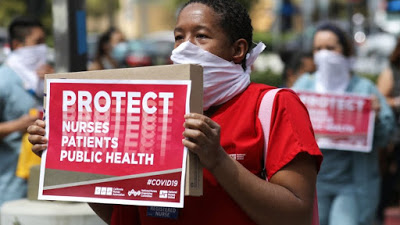The pandemic isn’t equal: Coronavirus hits the poor at most dangerous rate
 |
| Stephen Millies – April 5, 2020 |
The Covid-19 pandemic is devastating New York City. Forty-five refrigerator trucks are serving as mobile morgues to store the bodies. As of April 3, 51,810 people have been infected.
Inmates in the Rikers Island prison are being offered $6 per hour to dig mass graves on Hart’s Island off the Bronx. That’s the site of Potter’s Field, where a million people too poor to afford a funeral had their bodies dumped.
What’s happening in New York City is being repeated in Detroit, Chicago, New Orleans and Los Angeles. The coronavirus is ripping through the South with Black people suffering the most. About one in ten deaths has occurred in the adjoining states of Louisiana, Mississippi. Alabama and Georgia.
The Pentagon is seeking 100,000 body bags. The government’s stockpile of personal protective equipment ― a life and death matter for health care workers ― is almost depleted. But the Immigration and Customs Enforcement gestapo conducting deportation raids are guaranteed N95 face masks.
A hundred racist attacks against Asian Americans are occurring every day. Trump incited these attacks by calling the coronavirus “the Chinese virus.” We should call it the Trump virus.
New York Gov. Andrew Cuomo has taken advantage of the pandemic to roll back bail reform and ram through Medicaid cuts in the state’s budget.
Cuomo calls the virus “the great equalizer.” That isn’t true even if his own brother, CNN host Chris Cuomo, caught it. It’s certainly false with the city’s wealthy and powerful fleeing to the countryside.
It’s not just density
There’s nothing equal about this pandemic. The coronavirus has been much worse for New York City’s Black and Latinx communities. Orthodox Jewish communities in Brooklyn have been hard hit.
This writer lives two blocks from the Corona, Queens, N.Y., neighborhood where Louis Armstrong lived. Its 11368 ZIP code had 947 cases of the coronavirus as of April 1, the most of any in New York City.
Experts say New York City has been hardest hit because of its density. Nearly 9 million people live on about 300 square miles of land.
Corona, Queens, is crowded with 41,768 people living per square mile. Nine out of a thousand people there ― nearly one percent ― have been infected.
Murray Hill ― ZIP code 10017 ― on midtown Manhattan’s East Side is even more crowded, with 51,775 people per square mile. Yet the neighborhood’s infection is just a third of Corona’s.
The difference is that while Corona’s median household income is $45,964, the figure for Murray Hill is $100,652, over twice as high.
Adjoining Corona in Queens is Elmhurst (ZIP code 11373) with 831 cases and Jackson Heights (ZIP code 11372) with 492 people infected. The Elmhurst Medical Center is being overwhelmed.
All these neighborhoods are immigrant communities with many service and construction workers who had to continue going to their jobs while the pandemic was gripping the city.
Black and Latinx neighborhoods in the Bronx, Brooklyn and Manhattan have also been hard hit. The eastern Far Rockways in Queens, home to four largely Black housing projects, have 436 cases.
The capitalist government is covering up the impact on Asian, Black, Indigenous and Latinx communities. Maryland lawmakers are demanding a breakdown of those who’ve caught the virus.
Social distancing an impossibility
Medical experts recommend that people keep a “social distance” of six feet from each other. How are the 2.2 million prisoners locked up supposed to follow that advice? Cook County Jail in Illinois already has 213 prisoners with the virus.
For thousands of prisoners across the country, the coronavirus will be a death sentence. Activists like those in the Chicago Alliance Against Racist and Political Repression are fighting to free the most vulnerable prisoners.
The hundreds of thousands in homeless shelters are also not able to keep six feet from each other.
Social distancing is also impossible for the hospital and other “essential” workers taking overcrowded buses and subways in New York City. Ten members of Transit Workers Union Local 100 have died of the coronavirus.
Many essential workers who are risking their lives are among the lowest paid. The 3.6 million cashiers have an average annual income of just $22,430.
Experts are recommending that trips to the food store be limited to once every two weeks. How many working-class families can do that? Not the ten million workers who have already been fired.
Density and lack of social distancing won’t account for all the deaths. We’re told to wash our hands, yet 141,000 Detroit families have had their water shut off since 2014. Service hasn’t been restored for thousands.
It’s worse on the Indigenous reservations. Forty percent of Navajo nation households aren’t connected to a water pipe. They have to haul water to their home.
Overcrowded housing has skyrocketed because of rising rent. Many families are forced to move in with relatives.
Between 1980 and 2010, the number of these doubled-up families increased almost four-fold, 1.15 million to 4.3 million. (2012 U.S. Statistical Abstract, Table 59). Social distancing is impossible for them.
Millions of housing units are kept off the market to keep the rent high. A people’s movement is needed to seize them.
Homeless families in Los Angeles have taken over over 12 empty homes. We need to follow their example.


